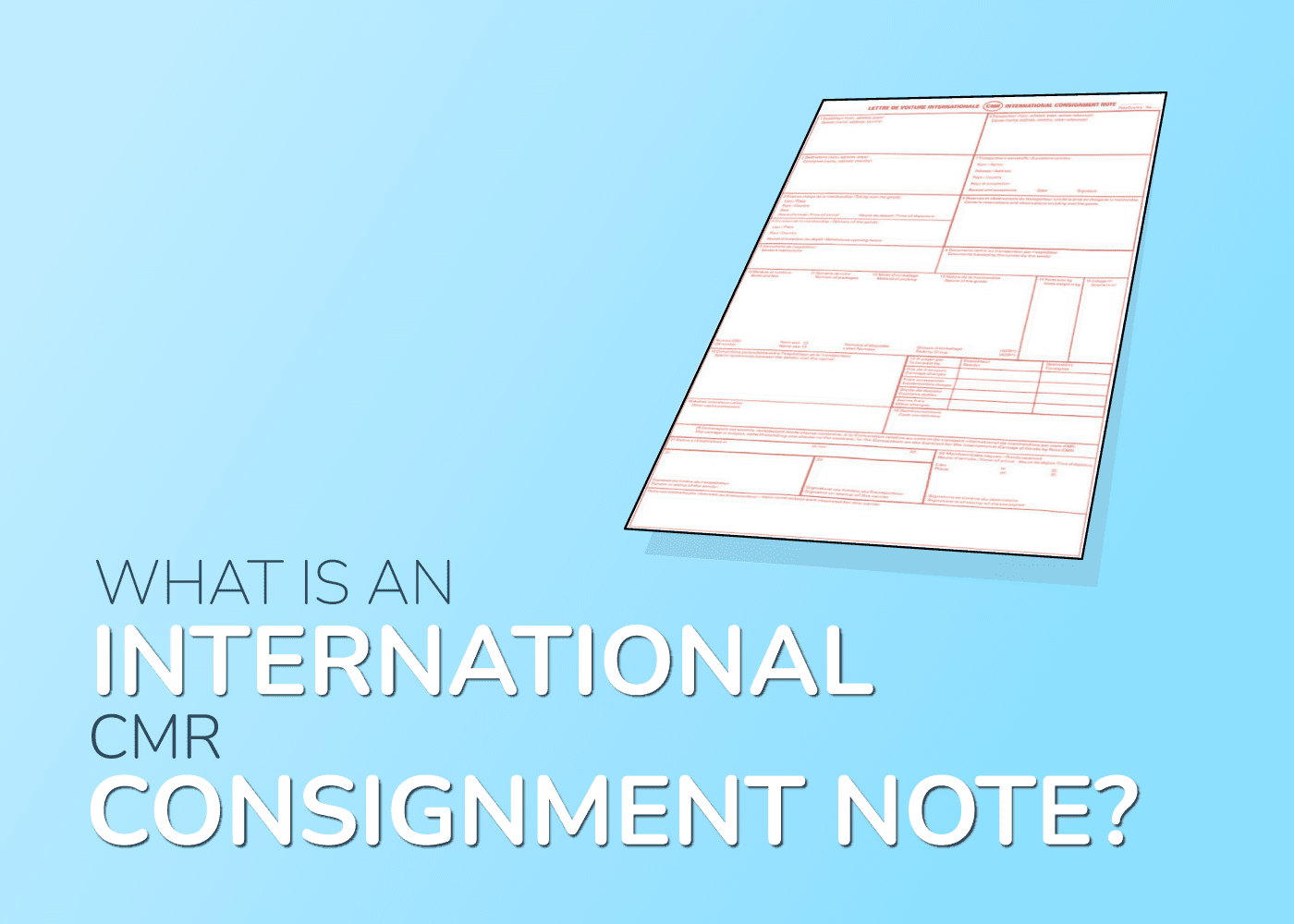The term CMR Transport Meaning refers to the “Carriage of Merchandise by Road” regulations that govern the transportation of goods internationally by road. The CMR convention ensures that a standardized set of rules is applied to all international road transport operations across member countries. The CMR document, or consignment note, is a vital legal contract between the sender, carrier, and receiver of goods, outlining responsibilities, rights, and liabilities. This article will explain the meaning of CMR transport, its relevance, and how the CMR consignment note plays a critical role in international trade.
CMR Transport Meaning: Overview
The CMR transport meaning involves the international transportation of goods by road under the rules set out in the Convention on the Contract for the International Carriage of Goods by Road (CMR). This convention regulates transport agreements between senders, carriers, and receivers, ensuring that the rights and responsibilities of each party are clear.
The CMR consignment note serves as proof that goods have been handed over to the carrier, establishes the terms of transportation, and outlines any limitations or liabilities in case of damage or loss during transit.
International CMR Consignment Note:
Or translated loosely as ‘Carriage of Merchandise by Road’ (CMR) is a carriage of goods document, used during international trading activities where goods are to be transported by road only. The CMR note is sometimes referred to as the ICN (International Consignment Note), and it contains information about the:
- Sender (Exporter of the goods)
- Carrier (Haulage firm responsible for transporting the goods by road)
- Receiver (Importer of the goods)
- Nature of the goods (whether dangerous or non-dangerous)
- Packaging of the goods
- Carriage Costs that may be charged
- Weights and Measure of the consignment
- Collection and Delivery details for the consignment
The CMR in paper form is split into four parts:
- Sender’s copy
- Carrier’s copy
- Receiver’s copy (and attached to the consignment till destination)
- Administration copy
Electronic version of the CMR Consignment note: With the advent of computerization, electronic copies of the CMR Consignment note are created, stored, distributed, and validated online on a paperless audit trail. However, where necessary PDF versions can be printed locally for paper versions. For more on electronic International Consignment Note, see online applications such as EdgeCTP, which are leading the way in paperless trading practices.
When is a CMR Consignment Note Required?
A CMR consignment note is mandatory whenever goods are being transported internationally by road between countries that have adopted the CMR Convention. For example, if goods are being transported from France to Germany by truck, a CMR consignment note must be completed.
Importance of the CMR Consignment Note
The CMR consignment note is more than just a receipt for the delivery of goods; it outlines essential contractual details such as:
- The responsibilities and liabilities of the sender and carrier.
- The conditions under which goods are transported.
- Protection in the event of delays, loss, or damage to goods.
By defining these aspects, the CMR note offers legal certainty, helping prevent disputes and clarifying responsibilities.
How to complete the CMR Consignment note
Logistics/Haulier or Freight Forwarder firms will be able to help you complete the CMR note and usually in paper copy form (4-part version). However, you are responsible for the information declared on the CMR Consignment note, so knowing how to complete an International Consignment Note is vital for your international trading responsibilities + knowledge. That said, the simplest way to learn how to complete a CMR Consignment note is to use an online application such as EdgeCTP, where for FREE you get field-by-field help in completing the CMR note template and then can generate electronic or paper versions as required.
Here is a summary of the International Consignment Note sections and what you need to complete those sections. Please note screenshots have been taken from EdgeCTP (where you can sign-up for a FREE 30-day trial and see how you progress without any obligations to continue).
1. Exporter Details
Provide the name + address details of your organization (if you are the sender/exporter of the goods).
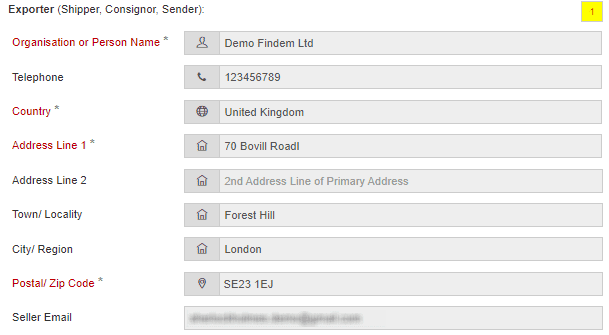
2. Consignee Details
Provide the name + address details of the buyer (the one who will receive the goods).
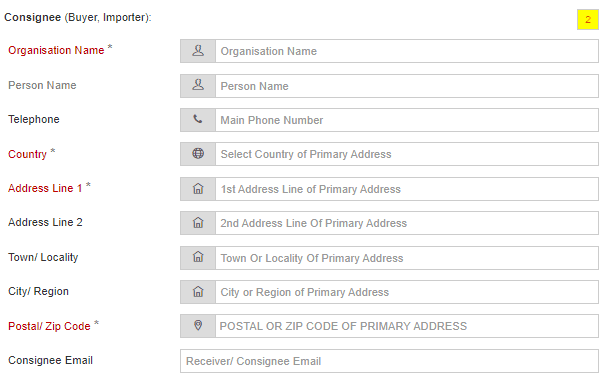
3. Goods Collection Details
Provide the collection place, date, and times when the carrier firm collected the goods for transportation.
4. Goods Delivery Details
Provide the delivery place and opening times to where the carrier firm must deliver the goods.
5. Sender’s Instructions
Provide any instructions to support the handling of the goods; Customs clearance; insurance or any other instructions associated with the transportation and safe delivery of the consignment by road, and that the carrier firm must adhere to.
6. Carriers Details (of principal carrier)
Provide the name + address + contact details of the carrier responsible for primarily transporting the goods to the destination location.

7. Successive Carrier Details (in case of multiple carriers)
Provide the name + address + contact details of the carrier responsible for concluding the transportation of the goods to the destination location. This section may/will need to be countersigned by the carrier upon receiving the goods + date of receipt + signature of receiving goods.
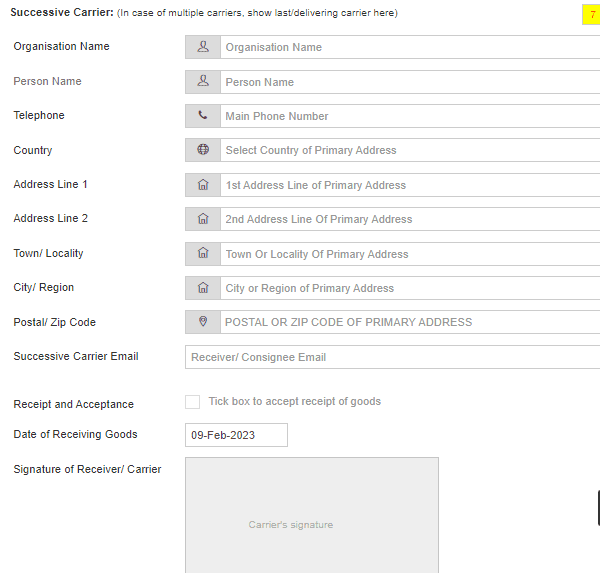
8. Carrier Reservations + Observations
Will be completed by the carrier, and will add comments on their reservation and observations at the point of taking charge of the goods, including adding the: a) number of consignment packages received; b) identification/ package marks or other numbers, and c) type of packaging. Any observations made here by the carrier must be endorsed by the Consignor (i.e. you as the exporter or sender of the goods).
9. Documents Handed Over
Indicate any additional documents that have been provided with the International CMR Consignment note and consignment to the Carrier. It is vital that a Commercial Invoice or Shipping Invoice is provided; in case the buyer needs proof of origin of goods, then a Certificate of Origin should also be provided; if the goods are covered under a trade agreement for reduced customs tariffs, then the associated Movement Certificate needs to be provided; if the goods are hazardous or dangerous in nature then a Dangerous Goods Note (DGN) may be accompanied (although the International Consignment Note already has provisions for Dangerous Goods); it is also prudent to add a Packing List for the goods being consigned.
10. to 15. Product Details
Provide the necessary details on the product(s) being consigned by road, including markings; quantities; packing; nature; weight, and measures, and in case of Dangerous or Hazardous goods, the UN and ADR details for the goods.
16. Special Agreement
Provide any special agreements particulars you (the sender) have agreed with the carrier, such as declaring the value of the goods; transportation time limits; handling and transportation considerations for the safe carriage of the goods; palette usage and loading, stowing, and unloading; ferry transportation admission; applicable jurisdictions, and transport contractual obligations upon both parties.
17. Payable Amounts by Sender (Consignor) and Buyer (Consignee)
Provide Carriage Charges; Supplementary Charges; Custom Duties and other Charges payable by both the Sender (exporter) and Buyer (importer) of the goods.
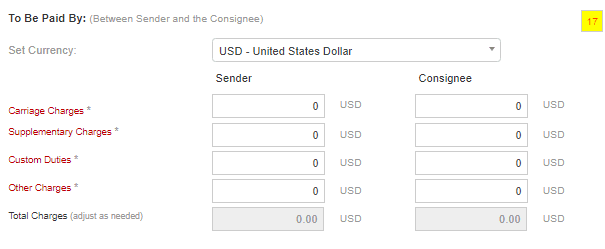
18. Other Useful Particulars
Provide any additional details that would be of use to other parties, such as vehicle license plate number; net weight of goods (gross weight is already stated); loading capacities; any relevant Carnets or Customs documents required during transportation of the goods.
19. Cash on Delivery
Provide the amount of monies that the Consignee MUST pay (reimburse) to the Carrier at the point of delivery and that the Carrier MUST pay to the Consignor (Sender) in full, even if the Consignee did NOT pay (reimburse) the exact/full amount. Any amounts MUST be paid in the denomination currency.

20. to 24. Declaration
For the Sender’s section (21 + 22), provide the Place International CMR Consignment note Created; Date CMR Create and sign/stamp the appropriate area.

The Carriers and Consignee/Receiver complete their sub-sections within this declaration portion of the International CMR Consignment note.
Where can I get a CMR Consignment note PDF?
You can get a CMR Note template from:
- Logistics/Haulier firms or Freight Forwarders – just make sure it’s the UN-aligned format
- HMRC (UK Government site)
- Online Export Documentation platforms (such as EdgeCTP featured above)
Additionally, you can use an online solution such as edgectp.com to help you generate paper and electronic versions of the International CMR Consignment note, just remember to use the free 30-day trial to see how you get on first.
Conclusion
Understanding the CMR transport meaning is essential for businesses engaged in international trade. The CMR consignment note ensures that all parties involved in the road transport of goods are protected and aware of their obligations. By following the guidelines and correctly completing the CMR note, companies can mitigate the risks associated with international transport and ensure smoother operations.
FAQs (Frequently Asked Questions)
What does CMR Transport mean?
CMR Transport refers to the international transportation of goods by road under the rules set by the CMR Convention. It governs the responsibilities and liabilities of the sender, carrier, and receiver in road transport.
What is a CMR Consignment Note?
A CMR Consignment Note is a legal document that acts as a contract between the sender, the carrier, and the receiver. It outlines the details of the shipment, including responsibilities and liabilities, and serves as proof that goods have been handed over to the carrier.
Who needs a CMR Consignment Note?
Any business involved in international road transportation of goods must use a CMR Consignment Note. It is mandatory for international road transport between member countries of the CMR Convention.
When do I need to use a CMR Consignment Note?
You need a CMR Consignment Note whenever goods are transported internationally by road between countries that are members of the CMR Convention. The note ensures legal protection for all parties involved in the transport.
How many copies of the CMR Consignment Note are required?
Four copies of the CMR Consignment Note are typically required: 1: Sender’s copy 2: Carrier’s copy 3: Receiver’s copy 4: Administration copy
What information is required in the CMR Consignment Note?
1: Exporter (Sender) details 2: Consignee (Receiver) details 3: Collection and delivery information 4: Carrier’s details 5: Product description and costs 6: Any special instructions or agreements

